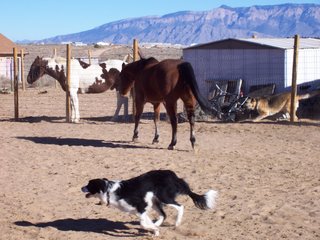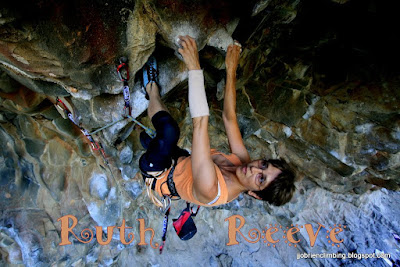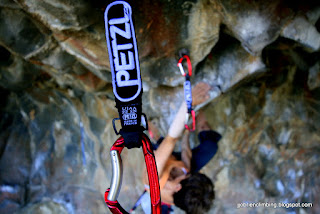 This bumble bee was sampling the flowers on my vitex bush.
This bumble bee was sampling the flowers on my vitex bush..I disapprove of what you say, but I will defend to the death your right to say it. ------ Voltaire
Monday, June 30, 2014
Monday, June 23, 2014
Me & Dogs


Here is a photo of me, Tuffee, and Codee taking a break while stacking hay for horses. And another shot of Tuffee, and Codee as they think they are herding my bay mare, Nita, and the paint, Sundance.
Saturday, June 21, 2014
The Pier at Fort DeSoto
After seeing the inside of the fort, we decided to go up on top of it and walk around. We wanted to get a better look at what else was at the park. We saw a nice beach. Excellent!

Then we look the other way and see a fishing pier and more beach. Even better!

Let's zoom in here and get a closer look:

Yup, that's where we want to head next! We take the short walk over there. We watch the fisherpeople fishing. We watch the birds and note how fearless of humans they are here.


And then the truly magical moment happened:

I saved the best for last-dolphins! I will tell you more about them tomorrow!
Living the life in Florida!

Then we look the other way and see a fishing pier and more beach. Even better!

Let's zoom in here and get a closer look:

Yup, that's where we want to head next! We take the short walk over there. We watch the fisherpeople fishing. We watch the birds and note how fearless of humans they are here.


And then the truly magical moment happened:

I saved the best for last-dolphins! I will tell you more about them tomorrow!
Living the life in Florida!
Wednesday, June 18, 2014
Meet the Reeves
 Let's start with Mrs. Reeve shall we?
Let's start with Mrs. Reeve shall we?Here's abeautiful example of the human spirit.
First climbing experience: The long, rambling "Caves Route", Grade 4.
For our international readers -that does not rate on your scale. It's too easy.
Totally freaked, and swore off climbing forever.
But something internally had changed.
Sheunlocked her inner steep climber.
 Can't get much steeper than that."Hung Like a Fruit Bat" 25 Coolum Cave
Can't get much steeper than that."Hung Like a Fruit Bat" 25 Coolum Cave
Let Ruth Reeve be a warning to 'fraidy women everywhere. Find your bravery, and you too could spend a year upside down workinga route like this.


What?Too much with the new "Logo" draws?You think?
The camera has trouble focusing on the climber when they are in frame.
You think I've forgotten Mr Reeve?
Hey, I'm not saying he is old, but here's a shot from the 30's of Dave on Hung Like a Fruit Bat.
 Hey Dave, you got the time?
Hey Dave, you got the time?Tuesday, June 17, 2014
Friday, June 13, 2014
Photographing the Lake Superior Ice Mountains

Last night I met up with my friend Bryan Hansel (http://www.bryanhansel.com/)to photograph the large mounds of ice that have formed along the shoreline in Grand Portage, MN. We met up about an hour before sunset and had a blast shooting the incredibly large and incredibly BLUE ice formations. When I set up this shot, Bryan was not in it but I knew if he was able to stand up on that tall mountain of ice it would really make the shot. So, I asked him if he could make his way there. Once he was in position I knew it was going to be a great shot. I think this is my favorite image of the evening.
Tuesday, June 10, 2014
Enchanted Gardens
Looking at these pictures has made me realise just how comfortable I've become cycling at night. Especially now that it's so hot during the day, that is certainly coming in handy. On Friday and Saturday nights, drivers tend to be more distracted and erratic - so being aware of that (and having one's bike lit up like a Xmas tree) will help you stay safe.
Monday, June 9, 2014
Edvard Munch
A lot of painters—and artists per se, lived very poignant and pitiable lives. Most of them had mental illness, suffered from severe depression and at some point were suicidal which makes you wonder and question the significance of their art. Perhaps this is the crux why they stand out, why their artworks have become world famous. It suitably and subtlety channels the volcanic chain of emotions gripping them in to their paintings, and then to the ordinary viewer, like you and me.

Like Edvard Munch, he was a great example of the above. He was constantly tormented by his psychoneurotic obsessively religious father who was utterly devoted to pietism, which I consider perilous by the way. I do not trust these radical religious fanatics.
So tomorrow I’m off to visit his legendary children—he was childless and considers his beloved paintings his children, and hopefully I will feel and experience the anguish he felt when he painted ‘The Scream’.
Until next week. In Oslo, Norway!

Like Edvard Munch, he was a great example of the above. He was constantly tormented by his psychoneurotic obsessively religious father who was utterly devoted to pietism, which I consider perilous by the way. I do not trust these radical religious fanatics.
So tomorrow I’m off to visit his legendary children—he was childless and considers his beloved paintings his children, and hopefully I will feel and experience the anguish he felt when he painted ‘The Scream’.
Until next week. In Oslo, Norway!
Sunday, June 8, 2014
Wild Things
Their hard to see 'cause the little critters don't let me get close to them. Photos were taken through the window. First one is of a Harris Ground Squirrelflattened out on the ground in the shade trying to stay cool in our heat. Second is of one by a pot of flowers. Theselookkind of like a very pale colored chipmunk like is found in the mountains.


A scaled quail coming in for water.

An English house sparrow.



This roadrunner has been coming in ever day at about 2pm. Here he drank, jumped on post and across to another where you can only see his tail. We have had lots of rabbits, and some large rock squirrels, as well as coyotes, and lots of other birds. An owl calls every evening and part of the night.



A scaled quail coming in for water.


An English house sparrow.



This roadrunner has been coming in ever day at about 2pm. Here he drank, jumped on post and across to another where you can only see his tail. We have had lots of rabbits, and some large rock squirrels, as well as coyotes, and lots of other birds. An owl calls every evening and part of the night.
Monday, June 2, 2014
How Do You Choose a Winter Bike?
With the snow bound to arrive any week now, I am hearing local cyclists talk about "winter bikes" again. Before my first winter of cycling, the very notion surprised me. You're supposed to ride a different bike in the winter than you do during the rest of the year? why?? But then I understood that not everyone's transportation bicycle is a "tank" that is already winter-proof. Some bikes are more suitable for winter conditions than others. And while there is no one bicycle that is universally considered to be the ideal winter bike, there are certain characteristics most cyclists would probably agree are beneficial for winter commuting in snowy climates:
Stability:One reason the number of cyclists decreases so dramatically in the winter, is that cycling on ice and snow is scary. On the right bike, it is much less so. A winter bicycle should handle well on slippery, snowy, muddy and plow-ravaged winter roads. City bicycles and mountain bikes tend to do best in this respect. Those who commute on aggressive bikes during the warmer months may prefer a more relaxed and more upright bike for winter, with wider tires. If there is a great deal of snow where you live, studded tires could be a good idea, or at least knobby tires. Tame, predictable handling becomes much more important than speed in the winter months. Stepover is another factor to consider. A slippery road surface can make it easier to lose one's balance when mounting and dismounting a bike, and even those who normally ride diamond frames might prefer their winter bike to have a step-though frame or a sloping top tube.
Reliability:Related to the above, it is important that the bicycle's crucial functions - in particular, braking power and shifting ability - are not compromised by winter conditions. Rim brakes and derailleur gears can function poorly (or not at all) if clogged with snow or frozen over, which is why many prefer for their winter commuter to haveenclosed hub brakes and hub (or single speed) gearing.
Durability:Understandably, cyclists may not want to expose their nice bikes to freezing temperatures and road salt, for fear that doing so might damage the frame and components. This is why some recommend getting a "beater bike" for the winter. Personally I am uncomfortable with this advice, because a beater bike is unlikely to be reliable (see above). The approach I prefer is to get a bike that is not vulnerable to the elements in the first place. A tough paintjob, stainless and aluminum components where possible, hub gears and a chaincase should get your bike through the winter relatively unscathed with little maintenance.
Visibility: Not only does it get dark much earlier in the winter months, but snowfall can further decrease visibility - making good lighting more crucial than ever.
Presentability:Just because it's winter, does not mean that we are no longer expected to look presentable at work. With road conditions messier than ever, it is important that a winter bicycle be equipped with features that protect the cyclist's clothing: full fenders, and ideally a chaincase or chainguard.
Taken together, these features suggest a number of candidates that could work especially well as winter bikes. If buying new, fully equipped classic city bikes are worth looking into: They already offer hub gears, hub brakes, a full chaincase, a resilient powdercoated frame, stable handling, generous fenders and reasonably wide tires. Recently I wrote about city bikes with mountain bike heritage, which might be particularly appropriate due to their super-stable handling. For those who prefer to put a bike together from scratch, frames with horizontal dropouts (suitable for hub and single speed conversion) and clearances for reasonably wide tires are now easily available from a number of manufacturers: Soma, Surly, Rawland, Rivendell, Salsa and Velo Orange are just a few that come to mind. For extreme conditions there are even all-terrain models that will fit monstrously wide tires, such as the Surly Pugsley and Moonlander, and the Salsa Mukluk. If you prefer to refurbish a used bicycle, an old mountain bike converted to a single speed and fitted with some upright handlebars could work nicely. Same with a vintage 3-speed, fitted with a modern wheelset with hub brakes.
It goes without saying that not everything mentioned here will be applicable to every cyclist who reads this. The kind of winter bike that is ideal for you will depend on everything from the harshness of your winters, to the character of your route, to your bike handling skills, to your bike storage situation, to the amount of time you are willing to devote to bike maintenance, and to the type of clothing you wear when cycling for transportation. Your current bike may already be a winter bike, either as is or with minor modifications. Or you may need to get an additional bike specifically for winter cycling. My own preference gravitates toward classic city bicycles, and those I've owned have made great winter bikes. But I've been increasingly curious to try a mountain bike with knobby tires and see how that compares. What is your idea of a winter bike?
Sunday, June 1, 2014
They've got just a little bling.
The vast majority of my ancestors were not well-to-do folk. They were mostly farmers and their wealth consisted mainly of family and friends, rather than material things. But every once in a while I come across a picture that makes me wonder if some of them really weren't all that poor. Case in point is the photograph below, which depicts my great-grandmother Amanda Minerva Alexander Wiseman. The fancy dress isn't one that a farmer's wife would wear on a daily basis. I wonder, just what was the occasion?
 The picture is not dated. Amanda was born on September 25, 1860 and was the first of four children of William and Rachel (Van Curen) Alexander. Amanda was married to Samuel Bray Wiseman on June 7, 1883 (her sister Laura married Sam's brother Henry).
The picture is not dated. Amanda was born on September 25, 1860 and was the first of four children of William and Rachel (Van Curen) Alexander. Amanda was married to Samuel Bray Wiseman on June 7, 1883 (her sister Laura married Sam's brother Henry).
From this other picture and several others of the Alexander siblings from my Dad's collection, I think that the Alexander's were one of the more affluent families in my lineage. Although with a total of 19 children between them (he was married twice and she once before they married each other), I don't see how William and Rachel managed. Of course, all of the children didn't live with them at the same time (the first one was born in 1841 and the last in 1868). Undoubtedly, the later children had it better than the earlier ones.
The photograph below (not a good copy of a copy, but the best I have) was taken earlier. Based on the ages of the children, probably about 1892/3.

Amanda and Sam Wiseman with their children.
Charles (my grandfather, born 1885), Goldie (born 1890), and Smith (born 1888).
Contributed to the "Bling, ancestor Bling" edition of Smile for the Camera.
 The picture is not dated. Amanda was born on September 25, 1860 and was the first of four children of William and Rachel (Van Curen) Alexander. Amanda was married to Samuel Bray Wiseman on June 7, 1883 (her sister Laura married Sam's brother Henry).
The picture is not dated. Amanda was born on September 25, 1860 and was the first of four children of William and Rachel (Van Curen) Alexander. Amanda was married to Samuel Bray Wiseman on June 7, 1883 (her sister Laura married Sam's brother Henry).From this other picture and several others of the Alexander siblings from my Dad's collection, I think that the Alexander's were one of the more affluent families in my lineage. Although with a total of 19 children between them (he was married twice and she once before they married each other), I don't see how William and Rachel managed. Of course, all of the children didn't live with them at the same time (the first one was born in 1841 and the last in 1868). Undoubtedly, the later children had it better than the earlier ones.
The photograph below (not a good copy of a copy, but the best I have) was taken earlier. Based on the ages of the children, probably about 1892/3.

Charles (my grandfather, born 1885), Goldie (born 1890), and Smith (born 1888).
Contributed to the "Bling, ancestor Bling" edition of Smile for the Camera.
Subscribe to:
Comments (Atom)

